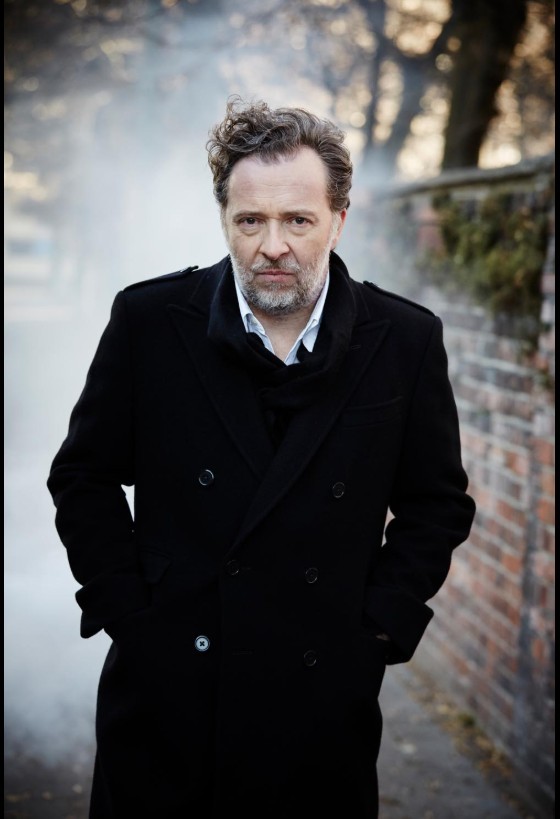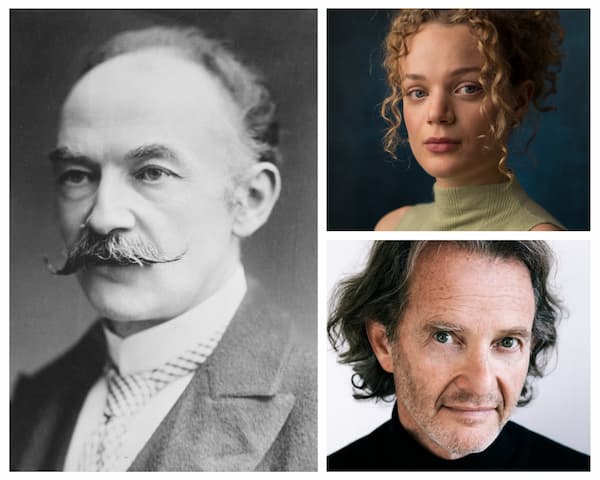An opera setting where the chorus flies on and off the stage onto metal platforms but otherwise stands without movement. An opera where the stagehands are ‘forced’ to move the scenery around by pistol-holding thugs in graffitied clothes. An Easter opera where a Christ-like figure pours dark red wine over himself. An on-stage football match where no one can score because each side threatens the other with guns. It just didn’t make sense.
That was the recent Cavalieri rusticana / Pagliacci double bill at the Greek National Opera. This new production of the two one-act operas was by Nikos Karathanos; the operas were paired in their settings with neon signage that came down over the sets, with steel platforms that had to be climbed or entered through narrow passageways, and the use everywhere of red flowers, which constituted almost the only colour element onstage, except for the graffitied central wind turbine.
Cavalleria rusticana & Pagliacci Trailer | Greek National Opera
Cavalieri rusticana, which in its libretto specifies that both Santuzza and Turiddu are young, were played by Ekaterina Gubanova (45) and Arsen Soghomonyan (40). They just didn’t work as young peasants. Their costumes didn’t work for young peasants. Turiddu’s first appearance is in a military uniform with a chest full of medals (whereas in the libretto, he’s just joined the military). Santuzza appears in a short flamenco-style flounced dress with a jewelled neckline. Not exactly the appearance of youth. And, more importantly than their appearance, their sound was the darker sound of age. You start to wonder – why is he still living with his mother? Why can’t she move on?
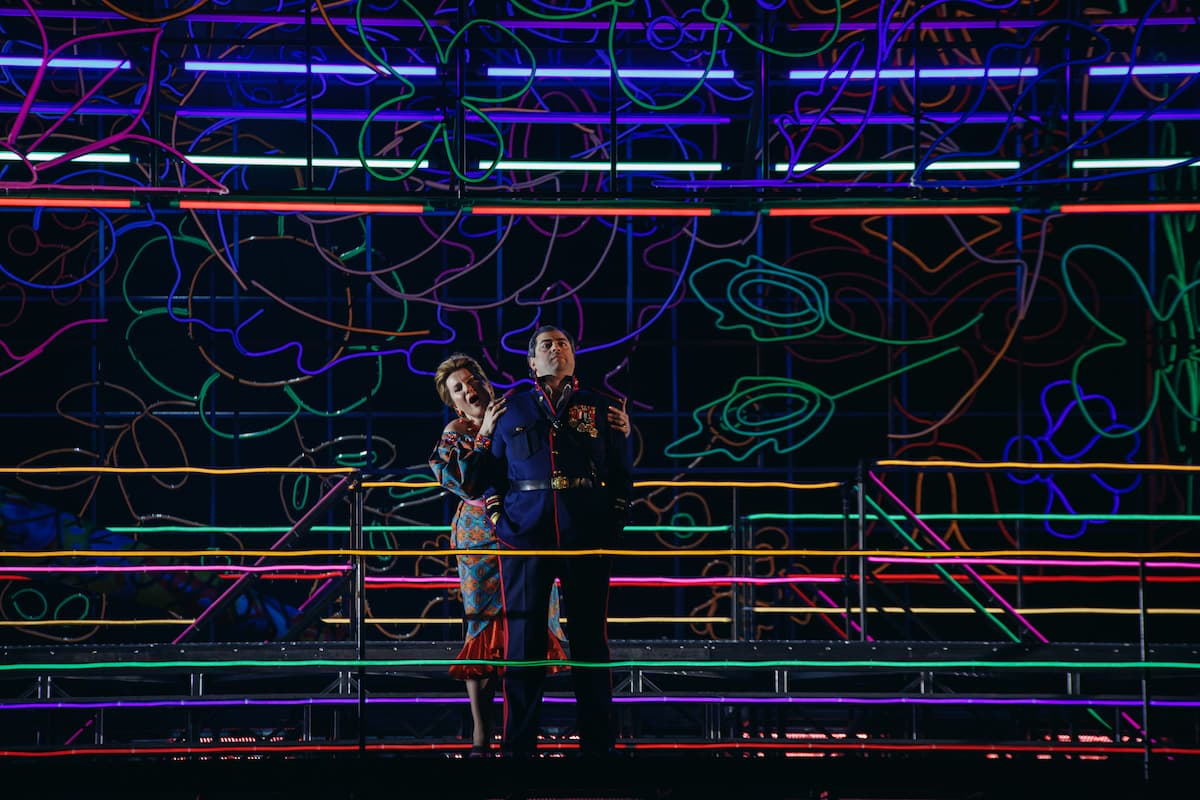
Cavalieri Rusicana: Santuzza (Ekatarina Gubanova) pleads with the adamant Turiddu (Arsen Sohomanyan), 2024 (Greek National Opera) (Photo by Valeria Isaeva)
The other cast members had even more puzzling costume choices: Alfio, the carter, is played by Dimitri Platanias (age 53), who has married the beautiful Lola, Diamanti Kritsotaki, the only youthful member of our principal quartet. She wears a bright yellow off-the-shoulder gown that looks like she’s off to the senior prom, while Dimitri has more grown-up clothes, including a long, heavy leather coat.
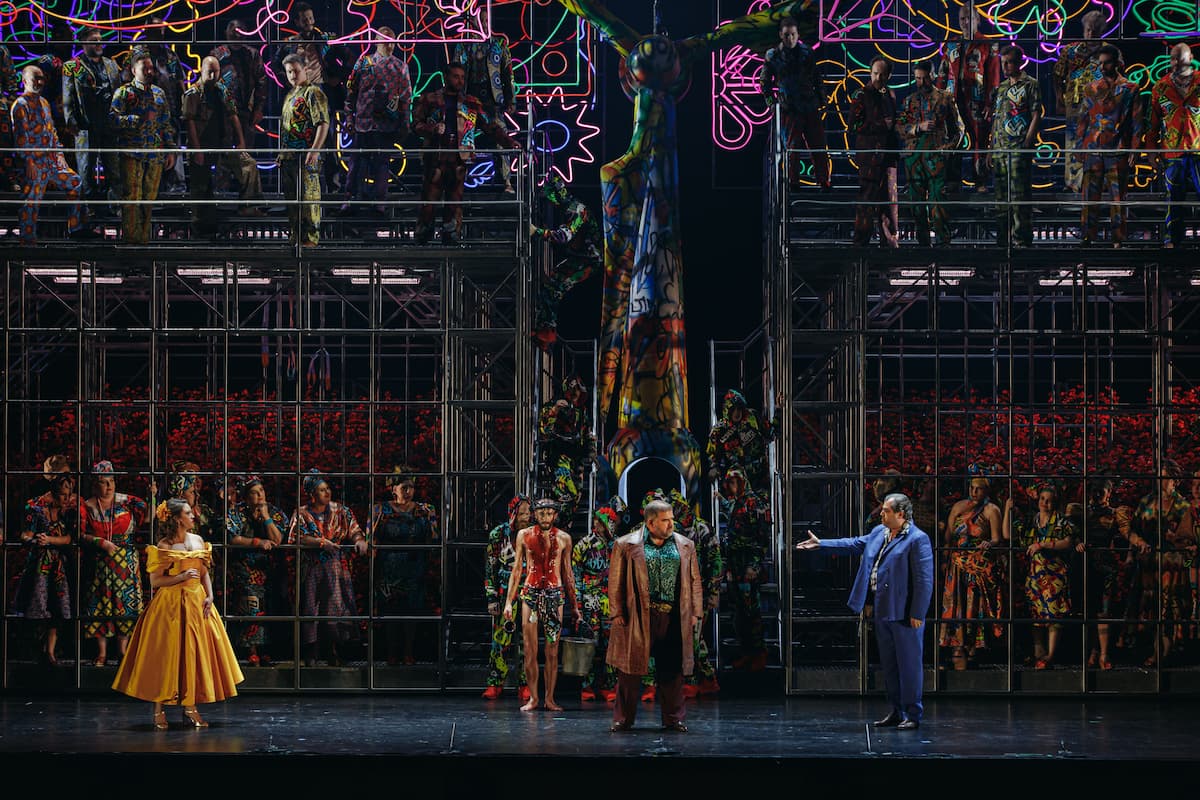
Cavalieri Rusicana: Lola (Diamani Kritsotaki) in yellow, Alfio (Dimitry Platanias) in brown, and Turiddu in blue), 2024 (GNO) (Photo by Valeria Isaeva)
The chorus is dressed in clothes made from very colourful African kitenge fabric, with the women also wearing headwraps of the same fabric. The men wore suits of kitenge fabric. They were quite beautiful but not exactly Easter wear. The colours of the chorus are saturated, bright, and echo the bright neon that was suspended above the stage.
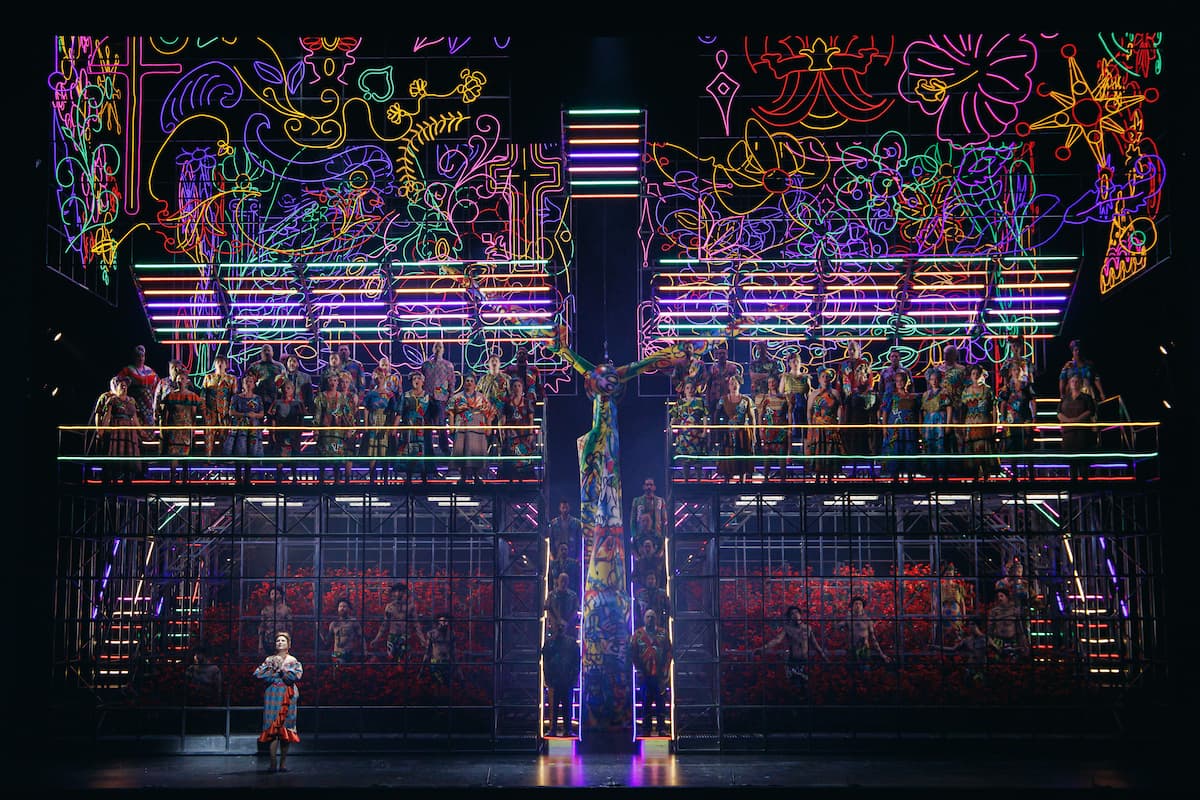
Cavalieri Rusicana: Santuzza with the disciples behind her and the chorus above, 2024 (GNO) (Photo by Valeria Isaeva)
Additional players were, as we thought of them, the ninjas and the disciples, the former dressed in graffitied sweatshirts and sweatpants and the disciples dressed in kitenge fabric trousers with their bodies covered in black writing, wearing crowns of thorns.
The opera opened with the metal staging and its banks of red flowers, with a Christ-like figure clad only in a loincloth and graffiti (a transparent overshirt) and a crown of thorns, standing in the flowers with his hands extended. As the overture ended, the ninjas rose from amidst the flowers and carried him off the stage.
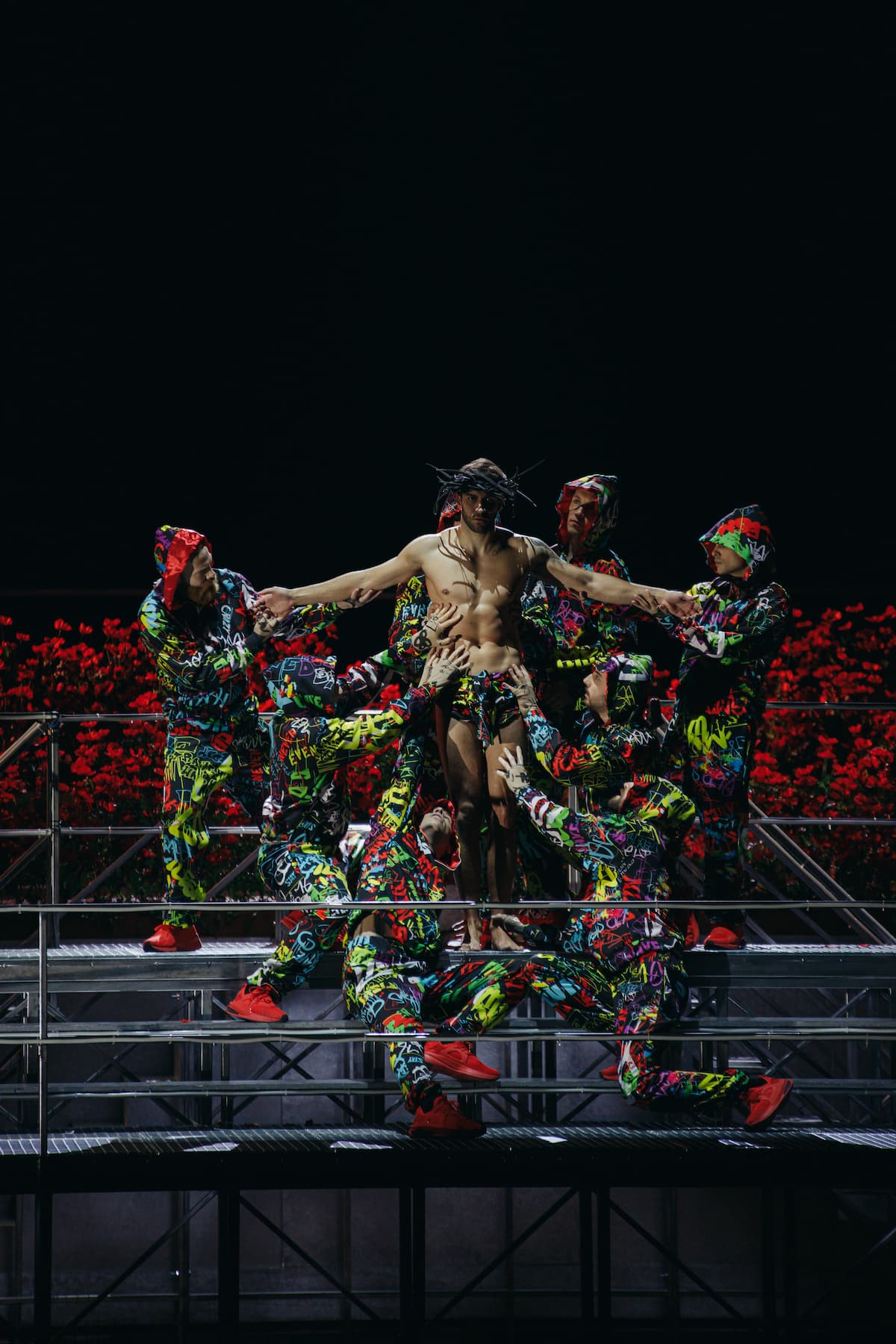
Cavalieri Rusicana: Opening scene, 2024 (GNO) (Photo by Valeria Isaeva)
Ok, it’s Easter, Christ is rising, etc., but who are these ninjas clad in graffitied hooded sweatshirts and sweatpants? Later in the opera, more men dressed as Christ, with the graffitied overshirt and loincloths, appear. There weren’t 12, so not apostles, but again, unexplained in the context. They largely spend their time draped over the metal staging with their arms outstretched or slumped at its base.
Some musical decisions held back the opera, such as the dropping of Turiddu’s opening aria praising Lola as he’s on his way to see her. After that, it seemed like all the accusations of him being Lola’s lover were entirely in the mind of Santuzza.
The chorus, once it had filed onto the metal staging, had to remain largely immobile. This meant other business had to be added to fill the extensive musical interludes, such as the procession of a woman dressed as Mary, who appeared so she could touch the hands of the chorus – but since she was a dwarf, the ninja picked her up and moved her across the stage. Was she real or a statue that they were moving around?
Turiddu’s appearance, where he meets his rival Alfio, has his entrance accompanied by a slumping Christ-like figure holding a bucket. Turiddu’s offer to Alfio of a glass of wine is declined, and Turiddu hands his cup to the Christ-figure, who fills it with dark red wine from his bucket and then pours it over himself, again and again. Why?
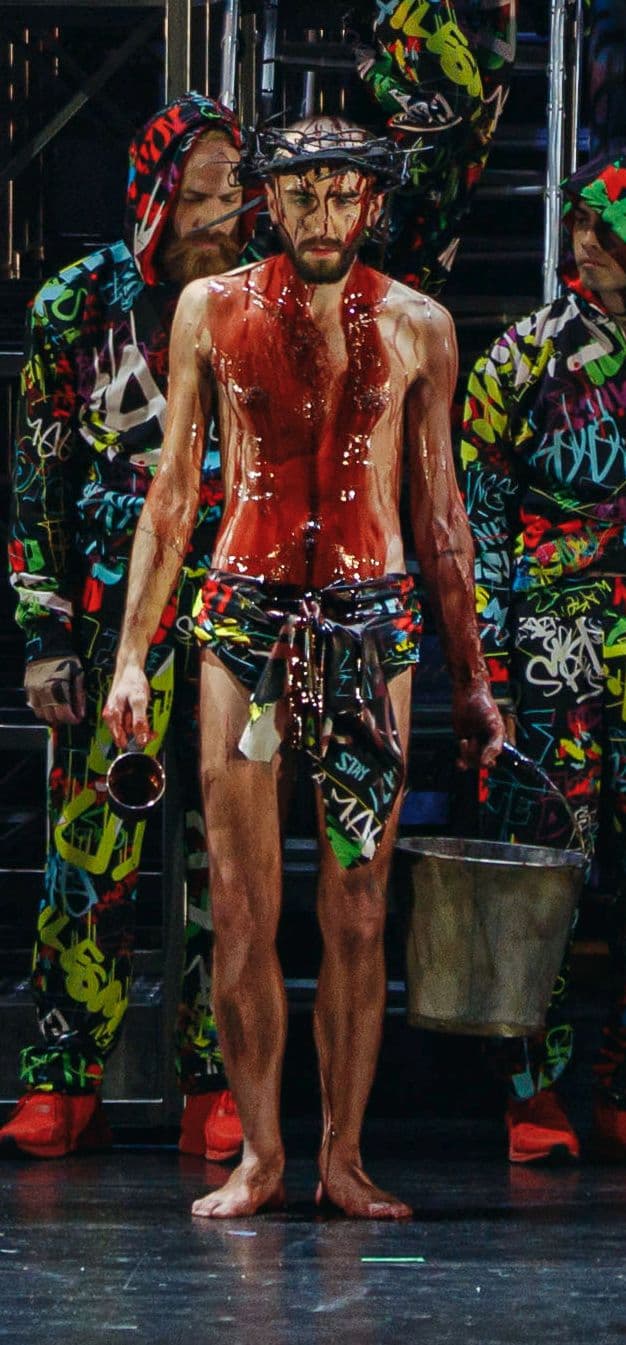
Cavalieri Rusicana: Covered in red wine, 2024 (GNO) (Photo by Valeria Isaeva)
Turiddu dies, and the opera ends. Throughout, the central wind turbine grinds on.
When Pagliacci opens, we are in the same village with its wind turbine and scaffolding. A troupe of players has arrived. The metal staging has been altered so that the cage-like fronts have been removed, and they are open. The banks of red flowers have been shifted to open more space, and on one side, Nedda (Cellia Costea) poses before her mirror. On the other side of the stage, Tonio (Dimitri Platanias) lounges in the flowers. Tonio confesses his love to her, but she laughs at him and makes fun of his deformity. He, of course, vows revenge. Tonio is dressed as the clown: grey clothes spotted with white and three pom-pom buttons, which he wears throughout.
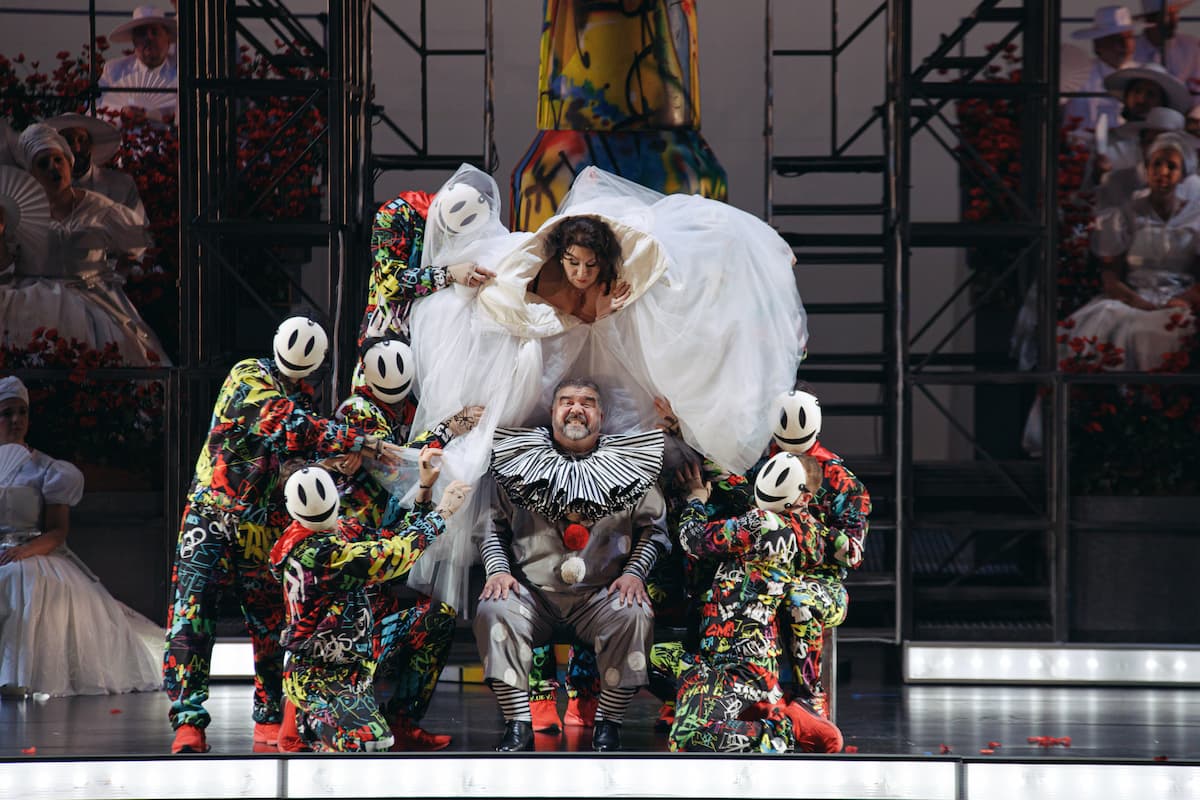
Pagliacci: Nedda (Cellia Costea) meets Silvio (Dionysios Sourbis), 2024 (GNO) (Photo by Valeria Isaeva)
Nedda next meets Silvio, who is hanging out with the ninjas. Instead of their graffitied clothing, he’s wearing silver shorts, a white soccer shirt, and occasionally, a giant rabbit head. She’s wearing a bouffant gown in layers of tuille, and he’s dressed for a day on the soccer pitch as the mascot. Tonio overhears their assignation. He goes and gets Canio, Nedda’s husband, so he can hear about it for himself (hiding behind the wind turbine). When he confronts Canio, he also confronts the ninjas who toss the rabbit head around to confuse him before assuming masks with smiley faces. He somehow can’t see the man dressed in silver who stands out from what’s around him in so many ways.
The highlight of opera is, of course, Canio’s aria ‘Vesti la giubba’, which is sung on an empty stage. After his line about laughter (‘Ridi Pagliaccio’), Canio sits onstage during the intermezzo. From opposite sides of the stage come one of the Christ-like disciples and the dwarf Mary from Cavalieri rusticani, who meet mid-stage, hold hands, and all three characters exit together.
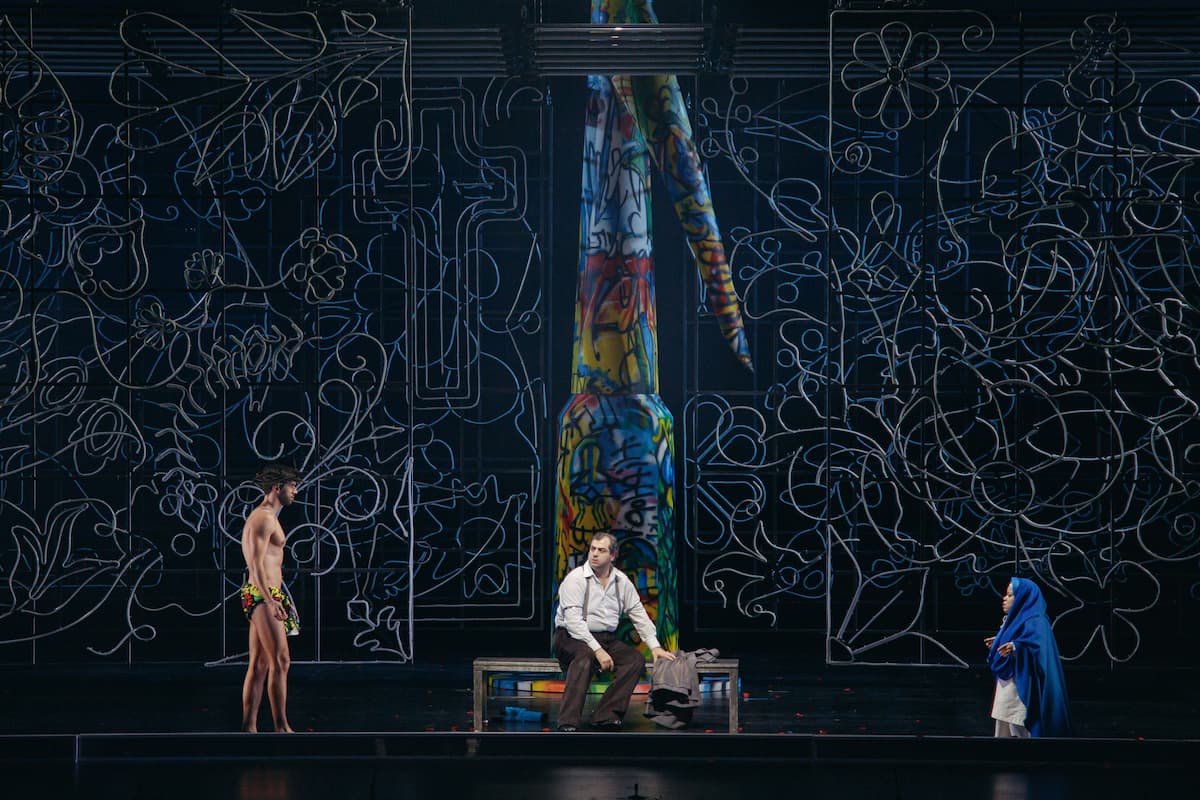
Pagliacci: Christ and Mary meet in front of Canio (Arsen Soghomonyan) , 2024 (GNO) (Photo by Valeria Isaeva)
Most productions normally drop the curtain and do a scene change. Adding in Easter-time figures from the earlier opera doesn’t do much to clarify the storyline.
In another inexplicable section to cover intermezzo music, the ninjas have a football match onstage, yet every time one side or another tries to score, the opposing players all bring out pistols to get the other side to withdraw. These guns first appeared in Cavalieri rusticana, taken out of Alfio’s bag. As the metal staging is moved on and off by the stagehands in black, they are also being threatened and ‘forced’ to do their work by the gun-carrying ninjas.
When the play-within-a-play about Columbine (Nedda) and Arlecchino (Beppe) starts, Tonio is still wearing the clown outfit, now with a black and white striped ruff. Arlecchino is not dressed in the classical Harlequin outfit of a checkered suit but wears an exaggerated black suit with wide-shaped trousers (rather reminding one of David Bowie’s Yamamato jumpsuit). When Canio (Pierrot) makes his appearance, he’s not in his commedia dell’arte clown costume, he’s just dressed in regular clothes with a silver wig and a silver waistcoat. Despite an entire aria about putting on his costume, powder, and paint, he’s used none of it. The whole established imagery of the deceived husband in his clown suit is completely lost since the wrong man is wearing the costume.
In the final confrontation, Nedda refuses his request to name her lover and is stabbed, Silvio rushes onstage and is stabbed as well. Tonio utters the last line: ‘La commedia è finita!’ (The comedy is finished) – in most many productions, this is Canio’s line.
The look of this opera was completely different from the colour saturated Cavalieri rusticana. Now, white came to the fore, with only Canio and Tonio and Beppe dressed in dark colours.
In Pagliacci the chorus of villagers was dressed completely in white. The children’s chorus made their appearance, also dressed in white. The costumes for both men and women (and children) consisted of white bell-like dresses over trousers, rather like plain versions of the traditional Greek pleated fustanella skirt/kilt. Their bell-like shape made them swing when the actors walked and didn’t contribute to their dignity.
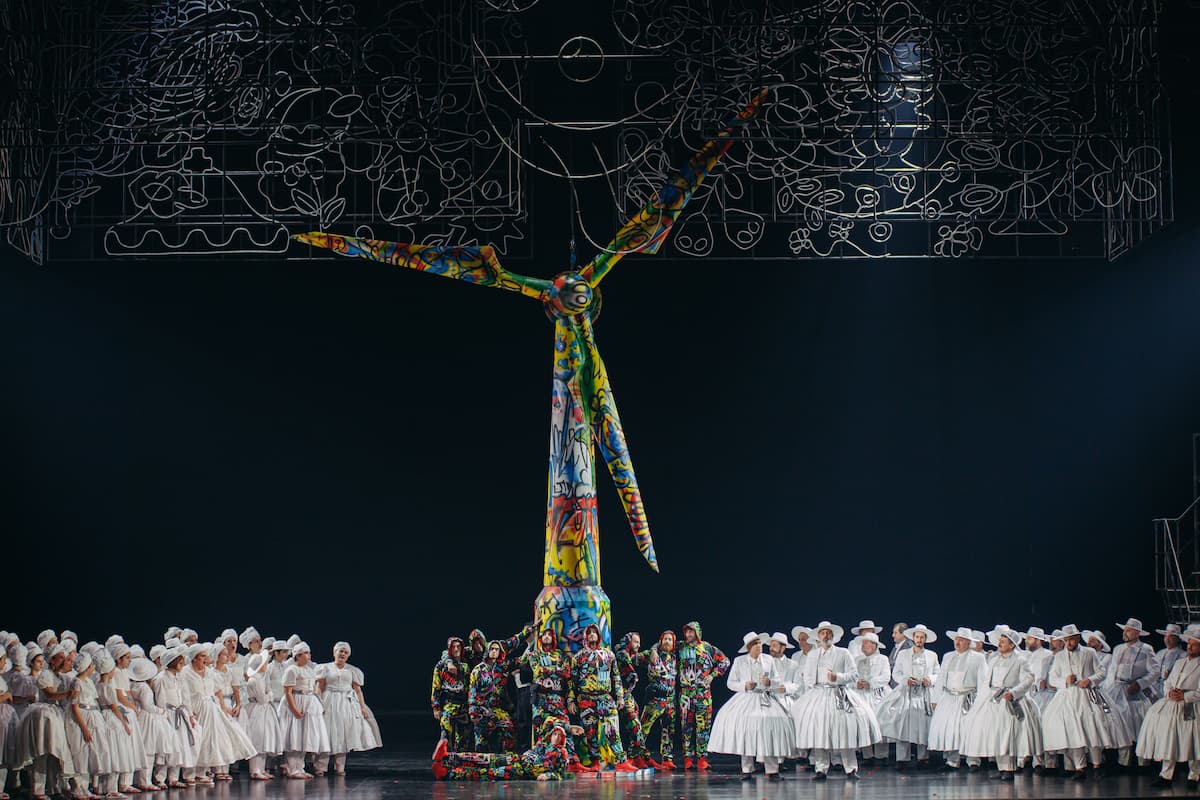
Pagliacci: Children’s choir on left, ninjas in the middle with the wind turbine, and adult chorus on right, 2024 (GNO) (Photo by Valeria Isaeva)
The voices of Pagliacci fit the older characters better. Nedda (Cellia Costea) had a wonderful light and frothy sound that fit both her character and her costumes. Canio (tenor Arsen Soghomonyan) conveyed the character’s constant worry and jealousy. Tonio (baritone Dimitri Platanias) was suitably threatening, although he lacked the traditional disfiguring hump. Beppe (tenor Yannis Kalyvas) ran the fine line between being Canio’s conscience and Nedda’s stage partner beautifully, and Silvio (baritone Dionysios Sourbis) despite the terrible costuming of a football mascot.
The metal staging forced long delays in getting the chorus on and off the stage single-file, although it did have the advantage of using the stage height well. One scene ended in Cavalieri rusticana with the entire structure being pushed backstage with the chorus still on it.
The chorus and orchestra were outstanding – with the audience left wishing that the director had a better idea of how to match the words and actions with the libretto, the characters, and their costumes. With more attention to detail, it would have been yet another of GNO’s outstanding productions.
For more of the best in classical music, sign up for our E-Newsletter
Greek National Opera
Cavalleria rusticana – Pagliacci
25, 28 Jan 2024
01, 04, 08, 11 Feb 2024

